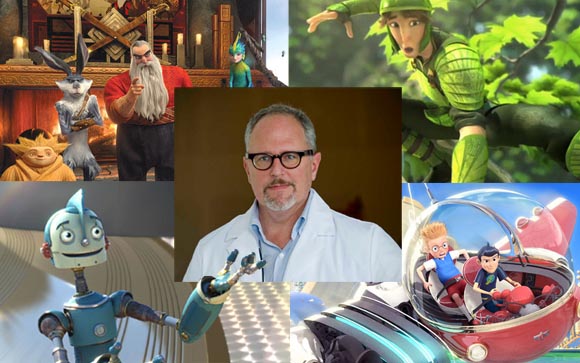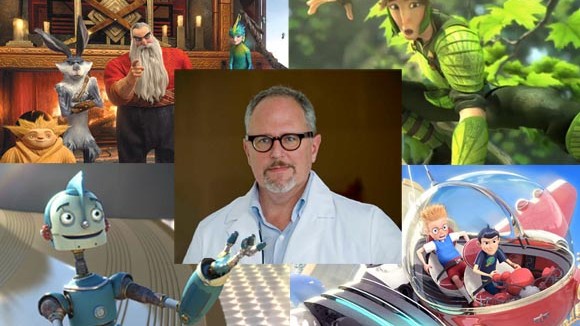

Was “Rise of the Guardians” A Victim of the Bill Joyce Curse?

Let’s make one thing clear upfront: this post is not intended to be an indictment of Bill Joyce’s creative abilities. Bill is one helluva of a talent. His self-produced animated short, The Fantastic Flying Books of Mr. Morris Lessmore, won the Oscar earlier this year. He’s a bestselling children’s book illustrator and author. He co-created the successful preschool series Rolie Polie Olie that ran for six seasons. He has been instrumental in jumpstarting a burgeoning tech scene in Louisiana. You could comfortably call him a Southern born-and-bred Walt Disney, and not be accused of hyperbole.
The William Joyce brand has been uniformly successful across various media platforms—except for one arena: CG animated features. The irony is that no artist has had as much personal success in having his ideas transformed into computer animated films as Joyce. He has produced three big-budget animated films at three different studios—Blue Sky’s Robots, Disney’s Meet the Robinsons, and DreamWorks’ The Rise of the Guardians. A fourth is on its way—Blue Sky’s Epic.
Deadline reported earlier this week that DreamWorks may take a $45 million write-down due to the poor performance of Rise of the Guardians. The film has grossed a paltry $72.9 million dollars after 29 days at the U.S. box office, and likely won’t break $100 million at the box office.
To put that into perspective, only two other DreamWorks CGI films have failed to reach the $100 mil domestic mark—the studio’s first CG feature, Antz, which made $90.7 million in 1998, and Flushed Away which pulled in $64.7 million in 2006. (The latter film was conceived and largely produced at the UK’s Aardman Animations.)
The performance of Rise of the Guardians falls in line with the tepid performances of Joyce’s other films. The first animated feature that he produced (and production designed) was Blue Sky’s Robots in 2005. That film grossed $128.2 domestically. It ranks as the lowest-grossing Blue Sky feature to date. (In the interest of full disclosure, I wrote the “art of” tie-in book for Robots.)
Joyce’s next feature, Disney’s 2007 effort Meet the Robinsons was based on the popular book A Day with Wilbur Robinson that he wrote and illustrated. That film grossed $97.8 million in the US, and is the lowest-grossing Disney feature in the John Lasseter-era of the studio. Neither Robots nor Meet the Robinsons performed well overseas either.
Joyce has maintained his reputation in feature film largely because the production process has been different on each film, as has his level of involvement. In the case of Robots, he didn’t write the script; he production designed the film and was intimately involved from a visual storytelling standpoint. The other two films have been based on his story ideas, but he hasn’t been involved as much visually as he was with Robots. The upcoming Blue Sky film Epic will be the first time that Joyce will both produce and production design a film that is based on one of his stories.
There’s also a strong argument to be made that Joyce’s involvement has nothing to do with the finished films. The films are only loosely based on his original ideas, and numerous other people mold the finished film besides Joyce.
For me, it begs the question: Why even use Joyce in the first place if studios deviate so wildly from his concepts. This was actually a lesson that Pixar learned the hard way. After Joyce had created concept art for Toy Story, Pixar invited him to direct an animated short at the studio. The experience didn’t end well, and all mentions of the unproduced short have been scrubbed from the studio’s official histories.
However, multiple people have told me that the experience with Joyce was instrumental in Pixar’s decision to develop film ideas in-house instead of working with outsiders and relying on pre-existing books or media properties as source material. Pixar, it has to be stressed, is absolutely unique in this regard; all other major animation studios have used pre-existing stories for their films, including Disney, DreamWorks, Blue Sky, Sony and Illumination. Pixar’s commitment to building ideas from scratch with artists who understand the medium best is among the reasons that the studio’s films are widely respected from a creative standpoint.
If this were baseball, Rise of the Guardians would have been Bill Joyce’s third strike in the world of big-budget CG-animated features. Thankfully, animation isn’t baseball, and Joyce will receive a fourth chance at CG feature success next May. Fox and Blue Sky’s Epic may prove once and for all whether there is such a thing as the “Bill Joyce curse.”

.png)